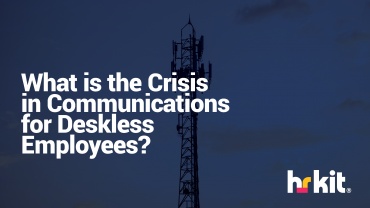Employee communications have exploded during the Covid-19 Crisis. Organizations have updated their crisis communication plans. Task forces have discussed what to do if an outbreak occurs locally. There are some great articles out there, and companies have been sharing best practices.
The problem is that the plans, content, and channels focus on desk-based employees. It is easy to communicate with an employee who has access to email on a device that their company gave them. Desk workers can transition to homeworking with ease. They just need a laptop and an Internet connection.
It’s much more of a challenge to reach the deskless workers in industries like manufacturing, retail, and health. During a crisis like Covid-19, these mobile workers still need to have access to information such as when they will be returning to work or how they are receiving their wages. These deskless employees require a way of asking questions and sharing their worries.
The Stranded Worker
Employees paid by the hour will probably panic if they are confused about the latest company policies and plans. Many mobile workers are paid by the hour in the ‘gig’ economy. If they don’t work, they don’t get paid. In a crisis, they become stranded.
If companies refuse to pay workers who are ill, they are likely to come into work anyway. The presence of sick workers will only add to the spread of disease.
Companies can stop workplace illness outbreaks by communicating clearly with employees that they will support them through the crisis. Precise messaging means that workers are more able to self-report when they are ill.
Company leaders also need feedback from employees even when they are stuck at home. There needs to be a two-way communication channel in place. Employees can ask questions, and managers can make the company policies apparent.
You can use Technology
If you don’t currently have a way of contacting employees not physically in the workplace, you can collect personal emails and telephone numbers of staff. It’s essential to be aware of security. When emailing several people, you need to use Bcc so that the email addresses aren’t showing. It’s also necessary not to use group chat, which shares cell phone numbers.
Companies with higher technology, such as an app or digital newsletter, have more choices about how they communicate with employees:
- Pin the latest news to the top of a feed so that vital messages won’t get lost. Give workers the option to comment on posts so that they can ask questions or describe their problems.
- For crisis alerts, you can maximize the readership by featuring the post to be bigger than the others. Then you can pin it and use a push notification.
- You can gather a record of who has read a post by using read receipts, which is useful for crucial information such as plant closure announcements. You can access a report that shows who has read the message.
Ask the Experts
You don’t need to create content about the virus. You can link messages to information from the World Health Organization (WHO) or the Centers for Disease Control and Prevention (CDC). These organizations are constantly updating their websites with the latest information that you can share with your workers.
Make sure the links you share work on a mobile, as the majority of deskless employees will be using a mobile device. Mobile-ready websites make sure all workers can engage.
Most organizations were not ready to deal with a crisis like Covid-19. This level of unpreparedness has been clear from the last few months. The lack of planning has been most apparent in the absence of communication with the deskless workers. This ignored group cannot work from home, and they need to go into work to earn money. The company must communicate efficiently with their mobile employees.
Now is the perfect time to assess your communications technology. Use an app or an internal intranet; there are various ways you can share messages from external organizations and your company updates.


